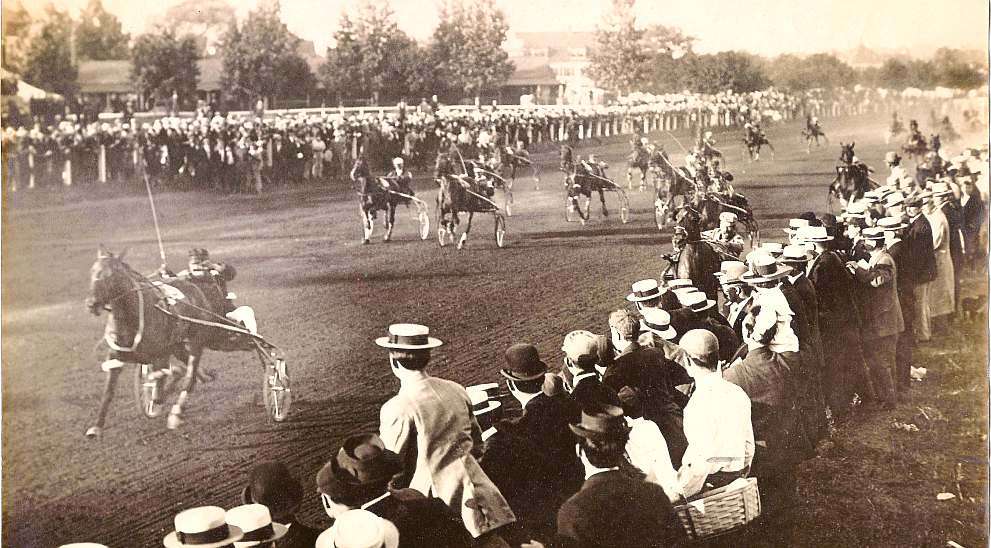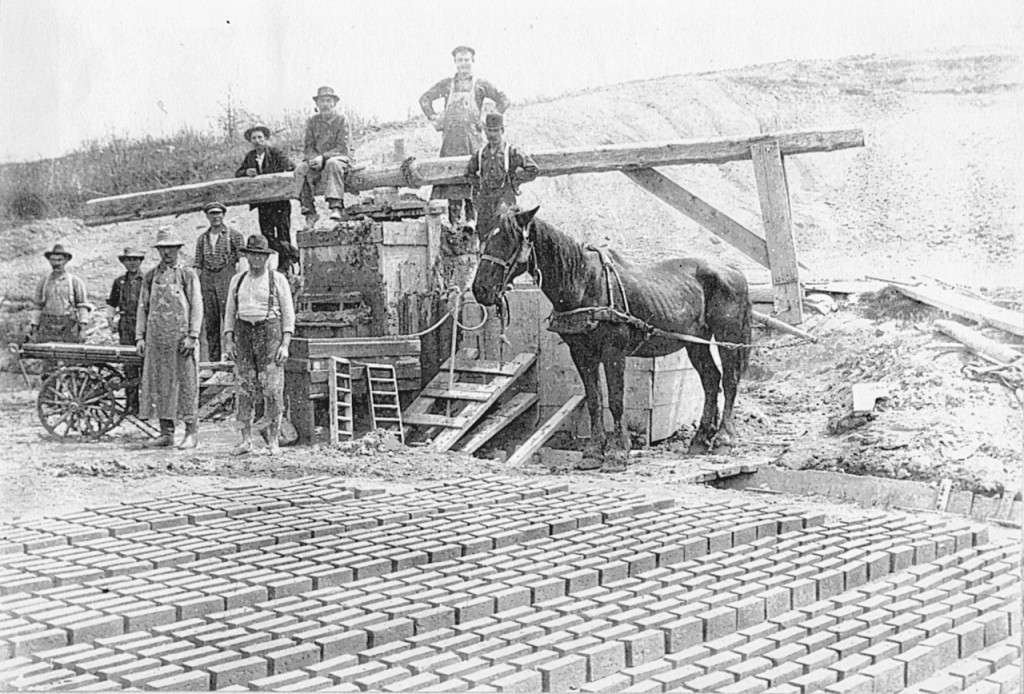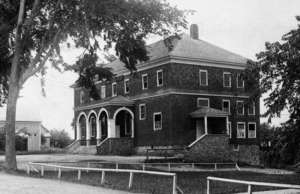TEAM PHOTO: Lawrence High School girls varsity soccer team
/0 Comments/in Fairfield, School News, Sports/by Website Editor
The Lawrence High School, of Fairfield, girls varsity soccer team, clockwise from bottom left, Hannah Burgess, Zoie Ward, Maddie Kissinger, Mya Williams, Olivia Cleaves, Kylie Yeomans, Zoe Hutchins, Kelsey Smith, Taylor Levesque, Kylie Delile, Alexis Williams, Paige Cyrus, Taylor Pellerin, Cyile Henderson, Brooklyn Allen , Whitney Churchill, Libby Boutin, Molly Cleaves and Desiree Clements. (photo by Missy Brown/Central Maine Photography)
Up and down the Kennebec Valley: Trotting parks
/0 Comments/in Albion, Augusta, Fairfield, Local History, Maine History/by Mary Growby Mary Grow
Your writer intended to deliver the promised article on Charles Hathaway and his shirt company, and more information on Waterville’s historic Main Street buildings, this week. But a reader reacted to last week’s digression on agricultural fairs with a question: what is a trotting park?
Hence another digression, which led your writer to a delightfully illustrated, highly recommended website: The Lost Trotting Parks Heritage Center (see box). This page will share some of the information from this and other sources.
Disclaimer: your writer is not a horse expert. Readers who are, please be kind.
A trotting park, also called a harness racing track, is an oval dirt racetrack, usually a mile long but sometimes shorter. Historically, a trotting park could be public, owned and maintained by an agricultural society of other organization, or privately owned.
On these tracks trotting or pacing horses race, each pulling a sulky with a single human occupant.
Wikipedia says most horses have four “natural” gaits, or “patterns of leg movements.” In order from slowest to fastest, they are called walk, trot, canter and gallop.
The Wikipedia writers describe the gaits in terms of two, three or four “beats.” The trot is a two-beat gait; the horse lifts left front and right rear hoofs simultaneously, then right front and left rear. Average speed is a bit over eight miles an hour.
Wikipedia’s illustrations include a photo of Thomas Eakins’ painting from 1879 or 1880 titled The Fairman Rogers Four-in-hand, or A May Morning in the Park. It shows a group of people in a coach drawn by four brown horses, the two lead horses clearly trotting.
The trot is a comfortable gait that a horse can maintain for hours, Wikipedia says. It is less comfortable for a human rider, who is bounced up and down; riders therefore learn to “post,” to raise themselves up and down in the stirrups in time with the horse’s motion.
The pace, called on another site an artificial gait, is also a two-beat gait, but the two legs on the same side of the horse’s body move together, so that the horse rocks from side to side – even less comfortable for a rider than trotting.
Harness racing could be for either trotters or pacers, Wikipedia says. In the United States, harness-racing horses must be Standardbred. Wikipedia says Standardbreds have shorter legs, longer bodies and “more placid dispositions” than Thoroughbreds.
A sulky, also called a bike, a gig or a spider, is a light-weight, single-seat horse-drawn vehicle with two large wheels.
On-line sites indicate that harness racing is common worldwide. In the United States, there are races for both pacers and trotters. A pacer or trotter who comes in top in each of three sets of races in the same year becomes a Triple Crown winner.
This year’s Windsor Fair program included harness racing. The Windsor Historical Society, headquartered on the fairgrounds, has information and photographs about past horses and races.
* * * * * *
Last week’s story mentioned trotting parks in China, Waterville and Windsor. Henry Kingsbury wrote in his Kennebec County history that China’s, Windsor’s and one of Waterville’s were public. China’s was built in 1868 and abandoned before 1892.
Kingsbury listed six nineteenth-century private parks in the county. Four were still operating in 1892, one in Farmingdale, one in West Gardiner, and two in Waterville, C. H. Nelson’s and Appleton Webb’s.
Palermo native and Civil War veteran Charles Horace “Hod” Nelson (1843 – 1915), of Sunnyside Farm, in Waterville, was an internationally recognized horse breeder; his champion trotter, Nelson (1882 – Dec. 4, 1909) set multiple records and in 1994 was named an Immortal in the Harness Racing Hall of Fame.
Your writer failed to find information on an Appleton Webb she is sure was a trotting park owner. Waterville lawyer and politician Edmund Webb’s son Appleton (Aug. 12, 1861 – Aug. 23, 1911) would have been about the right age; one website says he was admitted to the bar, and none links him with horses.
Other trotting parks in the central Kennebec Valley included one in Albion, three in Augusta (two private) and one in Fairfield (apparently private).
* * * * * *
Albion’s trotting park, according to Ruby Crosby Wiggin’s history, was in Puddle Dock, a locality in the southern part of town on Fifteen Mile Stream. The South Freedom Road crosses the stream there; near the bridge, a dam provided water power for various small industries for years, and Wiggin found the South Albion post office was nearby from 1857 (or maybe earlier) to about 1890.
The 1857 postmaster, she wrote, was D. B. Fuller, who lived “in Puddle Dock just opposite Maple Grove Cemetery and on the same side of the road as the trotting park.”
Maple Grove Cemetery is on the southwest side of South Freedom Road, just north of its eastward turn to cross Fifteen Mile Stream; so the trotting park would have been on the northeast side, between the road and the stream.
Wiggin continued her history of fairs in Albion, summarized last week, by saying that after the records she found ended in 1891, the fairs probably wound down, becoming “mostly horse pulling and a horse trot…held at the Trotting Park at Puddle Dock, just opposite Maple Grove Cemetery.”
To many 1960s Albion residents, she wrote, the park was “the place where they learned to drive their first car.” Not long before her history was published in 1964, the park was converted to a large plowed field (visible in an on-line aerial view).
* * * * * *
Augusta’s principal trotting park appears on old maps on the west bank of the Kennebec River, just south of Capitol Park. Newer maps show the area housing the Augusta police department and the YMCA building and grounds.
An on-line site shows a postcard with the typical oval track. Accompanying text says the trotting park was on a 22-acre lot.
Both James North, in his 1870 history of Augusta, and Kingsbury said the park opened in 1858. That year, North wrote, the State Agricultural Society chose Augusta as the site for its fourth fair. City officials and workers spent the summer getting ready.
North wrote, “A trotting park was graded and fenced at considerable expense, on the ‘Bowman lot,’ adjoining the State grounds, where the fair was opened Tuesday, September 21st.”
The 1858 fair was the Society’s most successful thus far, North said, with more and better livestock than ever before shown in Maine and a fine display of industrial and agricultural products in a 50-by-84-foot wooden addition to the State House. During “the ladies’ equestrian exhibition,” attendance was estimated at up to 15,000 people.
On Thursday evening, North wrote, the fair hosted a guest speaker on agriculture, United States Senator Jefferson Davis from Mississippi. Some auditors praised his agricultural knowledge; others detected a political message. North wrote that the Kennebec Journal called the speech “a bid for the presidency, with an agricultural collar and wristbands.”
Kingsbury wrote that up to 1892, the Augusta trotting park operated “with but few intermissions” under successive owners; in 1892, it was run by the Capital Driving Park Association. At some point, the postcard caption said, grandstands with space for 2,000 spectators were built.
In addition to racing and fairs, the park hosted circuses; and in 1911, the on-line site says, it was the landing place for the first airplane to visit Augusta, described as “St. Croix Johnstone’s Moisant monoplane.”
(Your writer could not resist exploring these names on line. She found that John Bevins Moisant [April 25, 1868 – Dec. 31, 1910] was an American aviator from Illinois who designed the Moisant biplane, which crashed on its first flight in February 1910, and the Moisant monoplane, which Wikipedia says “had difficulty staying upright on the ground and was never flown.” A different article says St. Croix Johnstone [another Illinoisan, born Jan, 2, 1887, and died Aug. 15, 1911] “flew a Moisant monoplane,” described as a United States version of the 1909 French Bleriot XI. Both aviators died in flying accidents.)
The Lost Trotting Parks Heritage Center website says Augusta’s two private trotting parks were on the east side of the Kennebec. George M. Robinson’s, built in 1872, was on South Belfast Avenue (Route 105). Alan (in other sources, Allen) Lambard’s, dating from 1873, was off Route 17. Kingsbury said both were “abandoned” by 1892.
North provided a short biography of Allen Lambard (July 22, 1796 – Sept. 5, 1877). He was by 1870 “in the evening of his days,” but still vigorous and interested in agriculture. His business ventures in Augusta and in Sacramento, California, had made him “the largest individual tax-payer in Augusta.” In October 1870, North wrote, he donated the house at the intersection of Winthrop and Pleasant streets as St. Mark’s Home for Aged and Indigent Women. The institution closed in October 1914.
The on-line Find a Grave site says Allen Lambard is buried in Augusta’s Forest Grove Cemetery. Other sources say Lambard was a grandson of Hallowell midwife Martha Ballard, made famous by Laurel Thatcher Ulrich’s publication of her diary.
George M. Robinson might be the man found on line who was born in 1823, died in 1888, and is buried in Augusta’s Mount Pleasant Cemetery; and might also be the man who made the March 25, 1876, Portland Daily Press after a gale blew down two of his barns.
* * * * * *
The Fairfield trotting park was located on the west side of town, west of West Street and south of the present Lawrence High School athletic fields. The Fairfield bicentennial history leaves its dates uncertain – it might have existed before 1872, while Fairfield was still called Kendall’s Mills, and it was very popular in the 1890s.
The local historians relied on two sources. One was a 1939 article by G. H. Hatch, who believed Edward Jones Lawrence (Jan. 1, 1833 – November 1918) and Amos Gerald (Sept. 12, 1841 – 1913) built the track “which was active in racing circles for years.”
Lawrence and Gerald owned and bred horses, according to Hatch. The first “really famous” Fairfield horseman, he said, was J. H. Gilbreth, whose horse named Gilbreth Knox was “a famous trotter of his day.” Gilbreth Knox is listed on line as a sire in the 1870s.
Lawrence acquired “the beautiful Knox stallion, Dr. Franklin,” listed as a sire in the 1880s.
The other mention of the trotting park in the Fairfield history tells readers that on Wednesday, Aug. 21, 1895, there was a “big event” at the trotting park that brought horses and people from miles around. The owners of the lumber mills in the downtown complex on the Kennebec River gave their employees the afternoon off to attend.
That day, for the third time, a fire started in a mill (earlier fires were in 1853 and 1882) and spread through the others. After the destruction, only one mill was partly rebuilt, and it didn’t last long. “Thus,” wrote the Fairfield historians, “the lumber industry in the Kendall’s Mills area of Fairfield, after a century of progress, came essentially to a close.”
The Lost Trotting Parks Heritage Center
The Lost Trotting Parks Heritage Center is a nonprofit organization in Hallowell, founded and run by Stephen Thompson. Its website describes its mission:
“to preserve the stories and images of the 19th century to present day that illustrate the history of Maine’s harness racing, lost trotting parks, fairs, agricultural societies, Granges, and the significance of the horse in society.”
A Kennebec Journal article from October 2021 says Thompson was looking for a space to turn his on-line venture into a physical museum.
Tax-deductible contributions are welcome. The website is losttrottingparks.com; the postal service address is Lost Trotting Parks Heritage Center, P.O. Box 263, Hallowell, ME 04347; and Thompson’s email is listed as lifework50@gmail.com.
Main sources
Fairfield Historical Society, Fairfield, Maine 1788-1988 (1988).
Kingsbury, Henry D., ed., Illustrated History of Kennebec County Maine 1625-1892 (1892).
North, James W., The History of Augusta (1870).
Wiggin, Ruby Crosby, Albion on the Narrow Gauge (1964).
Websites, miscellaneous.
PHOTO: The Central Maine Youth Football Junior Camp (2022)
/0 Comments/in Fairfield, Photo/by Website EditorEVENTS: Recycled Shakespeare Company to perform Much Ado About Nothing
/0 Comments/in Augusta, Events, Fairfield/by Website Editor
Sarah Mayven Crocker, back left, and Justine Wiesinger, back right, play the sparring Benedict and Beatrice with the slandered lovers Claudio, played by Emily Carlton, front left, and Hero played, by Helena Page, front right, in Recycled Shakespeare Company’s presentation of Much Ado About Nothing. (photo by Vanessa Glazier)
Submitted by Lyn Rowden
Recycled Shakespeare Company (RSC) is bringing fun and romance to the end of summer with their free performances of William Shakespeare’s much-loved comedy, Much Ado About Nothing.
Come hear some of the best witty repartee by Shakespeare when a strong independent woman tries to maintain her liberty in a battle of words with a jocular aristocratic soldier. Contrasting them are another couple caught up in scandalous gossip which comes dangerously close to ruining them. Meanwhile the officers of the law try to discover the truth despite their bumbling antics.
Bring a chair or blanket to see Much Ado About Nothing in an outdoor performance on Friday, August 19, at 6:30 p.m., in Mill Island Park, Fairfield. The theater in Central Hall Commons in Dover-Foxcroft will be the venue on Saturday, August 20, at 6:30 p.m. South Parish Congregational Church, in Augusta, welcomes all to their stage for a 2 p.m., matinee on Sunday, August 21. Concessions will be sold and donations most gratefully received at each show. Reservations for front row/best view tickets in Dover-Foxcroft and Augusta may be guaranteed with a $10 donation by calling 207-314-4730. As with all plays by RSC this show is free of charge and accessible to all. Much Ado About Nothing is a family friendly production.
The following weekend RSC travels to Aroostook County to perform outdoors at the Limestone Renaissance Faire, at Albert Michaud Memorial Park, at 1 p.m, on Saturday, August 27, and at noon on Sunday, August 28. Also on August 27, see the show at 7 p.m., at the historical Musee Culturel Du Mont Carmel, in Grand Isle.
RSC is Maine’s premier environmentally conscious, grassroots community theater. Dedicated to their motto that “all who want a part get a part,” this troupe is comprised of people of all ages and abilities from seasoned actors to first timers who come together to build Shakespearean plays from the ground up using royalty-free and primarily recycled/repurposed materials. RSC is proudly a founding member of the international EarthShakes Alliance to promote and practice the art of green theater.
For more information on becoming part of RSC or attending an event visit Recyledshakespeare.org, like and follow them on Facebook, email recycledshakespeare@gmail.com or call 207-314-4730.
Up and down the Kennebec Valley: Natural resources – Part 1
/0 Comments/in Albion, Central ME, China, Fairfield, Local History, Maine History/by Mary Growby Mary Grow
As the preceding articles have at least partly shown, pre-European inhabitants of the Kennebec Valley lived off the land, using natural resources to provide food, shelter, clothing, transport, decoration and other necessities and frivolities.
The first Europeans, arriving in small (by our standards) ships, had no choice but to imitate the Native Americans. They got food by hunting and fishing, built wooden shelters and grew crops suited to local conditions. However, they quickly branched out in two directions, monetizing many natural resources and adding imported and manufactured items.
Monetizing applied to wild animals, notably the sale of beaver and other furs to European traders; to fish, especially migratory species, a trade being revived in the 21st century; to forests, as land was cleared not only for houses and farms but for a lumber industry that covered much of Maine and continues today; and even to the ice that formed in the Kennebec River every winter and was exported globally (see the article on lumber driving and ice harvesting on the Kennebec in the May 14, 2020, issue of The Town Line).
The Kennebec Valley offered other natural resources that Europeans developed. Linwood Lowden, in his history of Windsor, mentions one of the most common: rocks.
After a would-be farmer in the Kennebec Valley cut down trees, hauled away the wood and dug out the stumps, he was usually left with a field full of rocks. Nuisances, yes, but, Lowden points out, useful: big ones were “drilled, split and removed to be used as foundation stones.” Smaller ones lined cellars and wells or made stone walls as field or property boundaries.
Some, Lowden wrote, were immoveable: the farmer and his friends would dig a hole and bury such problem stones. Smaller ones that continued to surface as the fields were plowed went to the “stone dump,” the otherwise unused area in some corner on every farm.
* * * * * *
The invaluable USM Digital Commons on line includes Mining in Maine: Past, Present, and Future, published in 1990 by Carolyn A. Lepage and others. This source considers granite, limestone, slate, feldspar and iron among Maine’s commercially important minerals.
In 1836, the Maine legislature hired a Bostonian named Charles Jackson to survey the state’s mineral resources. Lepage wrote that he inspected mostly coastal areas and “major river and overland routes.” From this sample, he concluded Maine minerals were worth developing.
By 1836, Lepage wrote, Maine was already an international granite exporter. Hallowell was one of five granite centers (plus Biddeford, Blue Hill, Penobscot Bay and Washington County).
The rest of the 19th century featured continued exploitation of resources, especially along the coast, and a brief period of excitement about gold, silver and other metals after the Civil War (with no indication that the Kennebec Valley was involved). Granite remained important; in 1901, Lepage wrote, the value of granite produced in Maine exceeded that from any other state. Maine’s granite industry slowly declined in the 20th century, especially during and after the Great Depression of 1929-1939.
A Maine Geological Survey website emphasizes slate, used especially for roofing tiles, as another important mineral. This site mentions the “Central Maine Slate Belt” that runs from the Waterville area more than 70 miles northeast to Brownville Junction.
* * * * * *
Another natural resource common enough to be mentioned in many town histories is clay.
Clay, Wikipedia says, is a fine-grained soil that contains clay minerals. Clay minerals, according to the same source, are “hydrous aluminium phyllosilicate minerals, composed of aluminium and silicon ions bonded into tiny, thin plates by interconnecting oxygen and hydroxide ions.”
These minerals are plastic – they stick together and are flexible – when they’re wet, but become rigid when they dry. The material can thus be made into many things, from bricks for walls to dishes for the people inside the walls to eat from.
Wikipedia provides more scientific information, including noting that clay is commonly found where water bodies, like glacial lakes, let the soil settle to the bottom. Since much of Maine was once under a glacier, the prevalence of clay is to be expected.
An on-line source says Maine clay is not particularly suitable for ceramics, but is excellent for brick-making. Residents exploited clay deposits for building materials, for houses and for larger structures like mills and public buildings.
In Albion, Ruby Crosby Wiggin’s history described a brickyard on the shore of Fifteen-Mile Stream, across from the Crosby sawmill (built in 1810 and operated into the 1880s). When George Crosby built the Crosby mansion in 1886 (see the June 11, 2020, issue of The Town Line for more on the stream and the Crosbys), he used bricks from the brickyard.
Wiggin listed specific uses: three chimneys, “a large brick oven and water heater in the kitchen,” “a large tank in the cellar which was used for the liming of eggs” and brick paving for the section of the cellar floor used to store potatoes. (Storing fresh eggs in a mixture of water and lime in a cool place was one of several ways to keep them edible before refrigeration.)
The front wall of the wooden ell added to the mansion in 1832 had a brick facing, Wiggin wrote. After part of it collapsed into the driveway some 50 years later, the remaining bricks were replaced with clapboards.
Wiggin mentioned another brickyard at Puddle Dock, in southern Albion, and yet another “along the clay flat beside Alder brook.” From the later, allegedly, came bricks used to build a brick schoolhouse.
This building was the town’s District 4 schoolhouse, shown on the 1856 Kennebec County map on the north side of what is now Route 202, opposite the north end of Quaker Hill Road. Wiggin quoted Henry Taylor’s memory of his father’s description of the building as “a brick schoolhouse with a wooden clock on the outside denoting the time, quarter to nine.”
No one seemed to know what significance, if any, that particular time held. A new District 4 schoolhouse off Quaker Hill Road was built around 1858, Wiggin wrote. She did not say whether any others of Albion’s 20 or so school buildings were brick, nor did she list owners of any of the brickyards.
The 1913 brick Besse building was originally Albion’s high school and now houses its town office (it is briefly mentioned in the Sept. 30, 2021, issue of The Town Line).
In China, various sources say there were at least three brickyards, along the north end of the east basin of China Lake; there might have been seven in the town, according to the bicentennial history.
The history describes how clay was turned into bricks. It was “shoveled into a circular pond; water was added; and the mixture was stirred with a long sweep propelled by a horse walking around the pond.” The resulting goop was put into a “hand-operated moulding machine” that could make six bricks simultaneously. The bricks were sun-dried and then kiln-baked.
Captain Nathaniel Spratt started his brickyard on the stream then called Wiggin Brook, which runs into the west side of China Lake’s east basin a short distance south of China Village, in the 1820s or early 1830s, according to Henry Kingsbury’s Kennebec County history. He ran it for 25 years; the bicentennial history says that in October 1834 he advertised in the China Village newspaper, the Orb, that he had 230,000 bricks for sale. Later owners were Samuel Benson and Zalmuna Washburn. The brickyard went out of business in 1865.
(The bicentennial history explains that two early Wiggin Brooks were named for the Wiggin [or Wiggins] family of early settlers, which included two Nathaniels, father and son, one of whom fathered 25 children. The west-side Wiggin Brook, later Broad’s Brook, flows under Neck Road; Kingsbury associates “Hollis Broad’s widow” with the Spratt brickyard. The other Wiggin Brook, now commonly Meadow Brook [or Hunter Brook or Starkey Brook] is larger and flows into the east side of the muldoon [swamp] at the head of the lake.)
There are numerous handsome brick houses along Neck Road, including one just north of the former Wiggin/Broad’s Brook.
On the east side of the head of the lake, the bicentennial history says Abraham Talbot, a former slave, operated a brickyard. The town comprehensive plan dates it tentatively to the 1790s (see the June 23, 2022, issue of The Town Line for more information on the Talbot family).
Neither Kingsbury nor the bicentennial history gives a name or location for a third brickyard.
One significant brick building in China Village was the double store on the west side of the south end of Main Street, facing east down Causeway Street toward the end of the lake. Built around 1825 by two residents, Alfred Marshall (the northern two-thirds) and Benjamin Libby (the southern third), it housed various stores and intermittently the local Masonic chapter, with the two sections changing ownership separately.
The Masons briefly owned the whole building in 1866, but they promptly sold the north section. In 1919 they reacquired that part; the entire building was the China Village Masonic Hall until 2006, when the organization finished building a new hall on the east side of Main Street and had the old building demolished.
The Fairfield Historical Society’s 1988 bicentennial history says nothing about brickyards, but it and other sources describe many significant buildings made of brick.
One of the earliest was William and Abigail (Chase) Kendall’s house, built in the 1790s at the intersection of Lawrence Avenue and Newhall Street, a block west of the downtown area that was for years called Kendall’s Mills. The history says the building later housed Bunker’s Seminary, founded about 1857 (see the Oct. 21, 2021, issue of “The Town Line); it served “as a Masonic Lodge and as a boarding house” before it was demolished in the 1890s.
An on-line history says that “The United Boxboard and Paper Company, a three story brick mill complex, was established in 1882 at the northern tip of Mill Island.” (Mill Island is the largest and westernmost of the islands in the Kennebec between Fairfield and Benton.)
This mill provided pulp for paper-making at “the company’s other paper mill at Benton Falls and the Hollingsworth and Whitney Company (later Scott Paper) in Winslow.” The northern end of the island is now the town-owned Mill Island Park, designed by Waterville dentist Steve Kierstead, with walking trails built by the town public works crew and remains of the mill foundations visible here and there.
On Aug. 21, 1883, the bicentennial history says, some of wooden commercial buildings on Main Street burned down. The writers surmise that the fire probably “stimulated the building of the first of the brick blocks” on the street.
The most elaborate downtown brick building is the former Gerald Hotel, opened on June 4, 1900. Designed by Lewiston architect William R. Miller (1866-1929) for Fairfield business magnate Amos Gerald (1841-1913), it is described as “a striking Renaissance Revival structure, with a sophistication of design and decoration not normally found in rural Maine.” The building served as a hotel until 1937, according to the history, and was considered “the most elegant, if not the largest” in New England.
After 1937 the building was for many years home to Northern Mattress and Furniture Company. It has been listed on the National Register of Historic Places since 2013.
The original Lawrence High School, on High Street, opened in September 1907, is yet another significant brick building in Fairfield (see the Oct. 7, 2021, issue of The Town Line). It is now Fairfield Primary School.
Main sources
Fairfield Historical Society, Fairfield, Maine 1788-1988 (1988.)
Grow, Mary M., China Maine Bicentennial History including 1984 revisions (1984).
Kingsbury, Henry D., ed., Illustrated History of Kennebec County Maine 1625-1892 (1892).
Lepage, Carolyn A., Michael E. Foley and Woodrow B. Thompson, Mining in Maine: Past, Present, and Future (1990) found on line.
Wiggin, Ruby Crosby, Albion on the Narrow Gauge (1964).
Fairfield election results (Spring 2022)
/0 Comments/in Fairfield, News/by Website Editor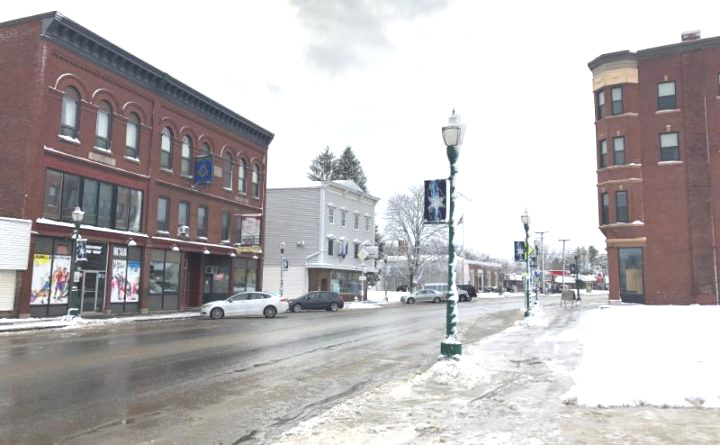
Looking south down Main St., in Fairfield. (Internet photo)
Unofficial returns from June 14, 2022, primary election according to Fairfield Town Clerk Christine Keller:
Governor:
D – Janet Mills, 192
R – Paul LePage, 366
Representative to Congress, District 2
D – Jared Golden, 198
R – Bruce Poliquin, 231
R – Elizabeth Caruso, 146
Maine State Senate, Dist. 16
D – David LaFountain, 192
R – Mark André, 58
R – Kevin Kitchin, 208
R – Michael Perkins, 117
Maine House of Representatives, Dist. 67
D – Robert Sexak, 199
R – Shelly Rudnicki, 352
MUNICIPAL
MSAD #49 School Budget Validation Referendum
Yes, 472
No, 226
MSAD #49 Continue 3-year Budget Cycle
Yes, 524
No, 167
MSAD #49 School Board
Rae Davis-Folsom, 582
Marlisa Golder, 5
Karen Kusiak, 34
Blank/Other, 111
Question 1: Public Water Expansion
Yes, 282
No, 402
Memorial Day Festivities 2022
/0 Comments/in China, Events, Fairfield, Madison/by Website Editor Memorial Day Festivities
Memorial Day Festivities
South China Memorial Day Ceremony
Mon., May 30, 11 a.m.
Veterans Memorial Park
American Legion Post 179
Ceremony only, NO PARADE
China Village
China Village Memorial Day ceremony will be held at 10 a.m. Meet at the Causeway Rd. FMI: Contact Mary Lockhart at 968-2717.
Town of Fairfield Memorial Day parade canceled
The Fairfield Memorial Day parade has been canceled due to the lack of participants and bands. The graveside tributes and luncheon will take place as scheduled, hosted by Fairfield VFW Post #6924, 246 Main St., Fairfield, 207-453-2565.
Madison Memorial day
Please join the members of The Tardiff-Belanger American Legion Post #39 and American Legion Auxiliary Unit #39, Madison, in honoring Our Fallen Heroes on Memorial Day, May 30, at the Memorial Day Ceremonies with guest speaker Brad Farrin, State Senator. Starting at 9 a.m., at Starks Town Office, 9:30 a.m., at the Veterans Monument, at Anson Town Office, followed by scattering of flowers off the bridge; 10 a.m. at the Veterans Monument, at the Madison Library; 10:30 a.m., at the US/Canadian Monument, at Forest Hills Cemetery, on Park Street ,and at 11 a.m., at the Joseph Quirion Veteran Monument, in the center of East Madison.
Mikala Ferland named Ezhaya scholarship winner
/0 Comments/in Community, Fairfield, Waterville/by Website EditorMid-Maine Chamber of Commerce has announced the 2022 Joseph B. Ezhaya scholarship winner.
Mikala Ferland was selected as the scholarship recipient from a field of applicants.
Mikala is one of the top students in her class at Lawrence High School, in Fairfield. She also completed a Health Science Certificate at KVCC while still a senior student. She values citizenship and responsibility, along with having a passion for music and martial arts. Her stated mission is to make a significant difference in the lives of others as she moves forward.
Mikala was a member of the National Honors Society and served as secretary and representative of her class during her high school tenure. She assisted in teaching and has participated in martial arts for over seven years. She has a long list of musical accomplishments in her background. Mikala serves as a lifeguard at the Alfond Youth and Community Center (AYCC), in Waterville, since 2020 and has dedicated over 320 volunteer hours at Camp Tracy.
Mikala will attend Kennebec Valley Community College’s nursing program, in Fairfield, in the fall.
The Joseph B. Ezhaya scholarship was established in memory of Joe Ezhaya, a community leader who was known for his generosity and dedication to civic engagement.
Up and down the Kennebec Valley: French-Canadians – Part 2
/0 Comments/in Fairfield, Local History, Maine History, Waterville/by Mary Grow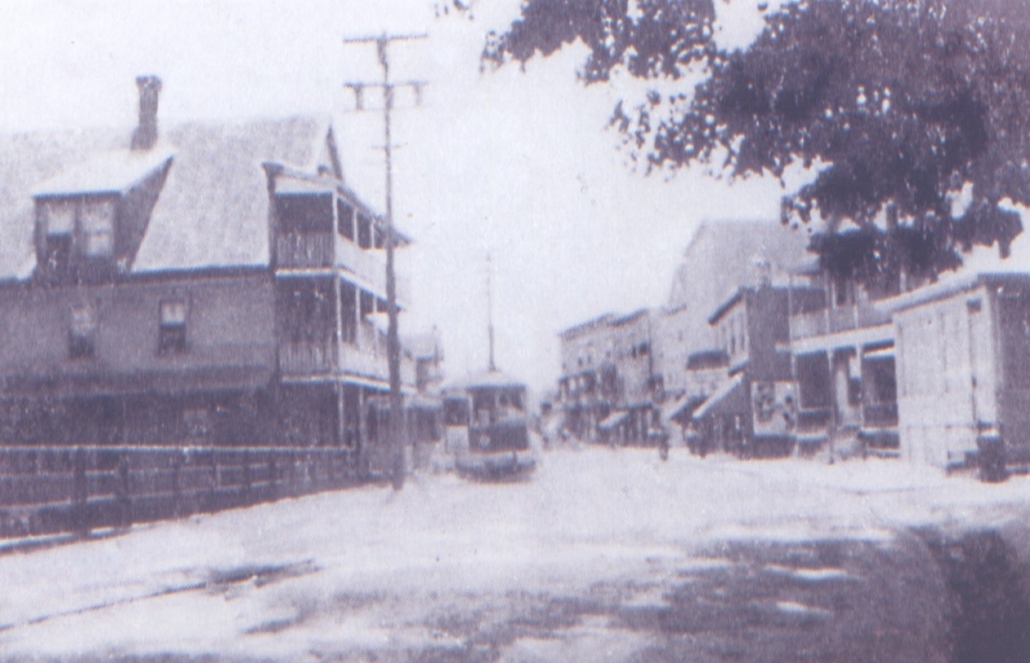
Water St., Waterville, The Plains, circa 1930. Note the trolley in the center of the photo. The trolley ceased operations on October 10, 1937. Many of the buildings in this photo are no longer there. (photo courtesy of Roland Hallee)
by Mary Grow
(See part 1 of this series here.)
French-Canadians Part & other Catholics
The story of French-Canadian immigrants in the Augusta and Waterville area, as presented by the writers cited, is partly a story of separateness and discrimination evolving into cooperation and mutual respect.
* * * * * *
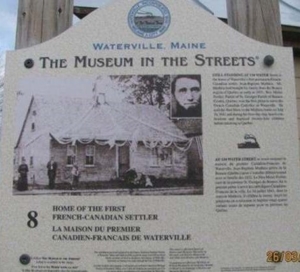
One of the stations of Waterville’s Museum in the Street in front of the home of Waterville’s first permanent Canadian settler, Jean Mathieu.
Steven Plocher’s on-line history says Québecois began to come to Waterville in the 1820s, first as temporary workers and after Jean (or Jean-Baptiste) Mathieu (or Matthieu) arrived in 1827 as permanent residents. Their numbers increased after the Kennebec Road from Québec Province was improved around 1830.
An on-line history by a writer identified as Bob Chenard, drawing on other histories of Waterville’s French-Canadian community, says in the 1820s Mathieu came as far south as Shirley (between Monson and Greenville) and started a food delivery service for lumber camps and settlers north of Bangor.
When he came to Waterville, he moved a wooden house from Fairfield to the east side of Water Street, in an area in southern Waterville called La Plains, “The Plains”. Plocher said his house served as the first French Catholic meeting house. Whittemore, in his 1902 Waterville history, said Father Fortier said the first Mass there. Neither historian gave a date.
Chenard described The Plains as the area along Water Street and side streets off Water Street. When settlement began, the land was “thickly wooded,” with occasional small clearings where livestock could graze. He said there were about 300 French families in Waterville, mostly in The Plains, by the early 1830s; your writer considers the figure of about 30 families in 1835, given by George Dana Boardman Pepper in his chapter on churches in Whittemore’s history, more likely to be accurate.
Most of the inhabitants of The Plains “were very poor,” Chenard wrote. “Some excavated and reinforced shelter in steep slopes as temporary homes. The most prosperous owned some domestic animals.”
Whittemore added an anecdote: “One of the citizens whose wealth now amounts to several tens of thousands of dollars tells how an unsuspicious cow who had strayed upon one of these turf roofs came down through it into the midst of the astonished family.”
Job opportunities Chenard listed included clearing the area that became Pine Grove Cemetery, working in sawmills and other manufactories, farming, lumbering, quarrying and brick-making. In 1855, construction of the first railroad through Waterville provided more jobs and created a second Franco-American settlement in the north end of town.
As mills and manufacturing developed in the 1860s and 1870s, job opportunities multiplied, and more French-Canadians, in Plocher’s words, left behind “their struggling farms and the British government in Québec for the economic prosperity and relative freedom found in the U.S.”
Chenard said “Waterville’s first grocery stores” were opened on Water Street in the 1860s, by “Peter Bolduc and Frederick Pooler (Poulin).” New French-Canadian stores continued to open in the 1870s; Chenard mentioned clothing and jewelry stores, and Plocher wrote,” After the first French store opened in 1862, dozens of other businesses and services followed suit: before long there were stores, doctors, dentists, lawyers, even a theater, all in the Plains.”
A successor store that Kingsbury described was John Darveau, Jr.’s, grocery, opened in 1876. Darveau was born in St. Georges, Québec, Kingsbury wrote; assisted by his brother, Joseph Darveau, and Henry W. Butler, he ran the store until he died in 1891.
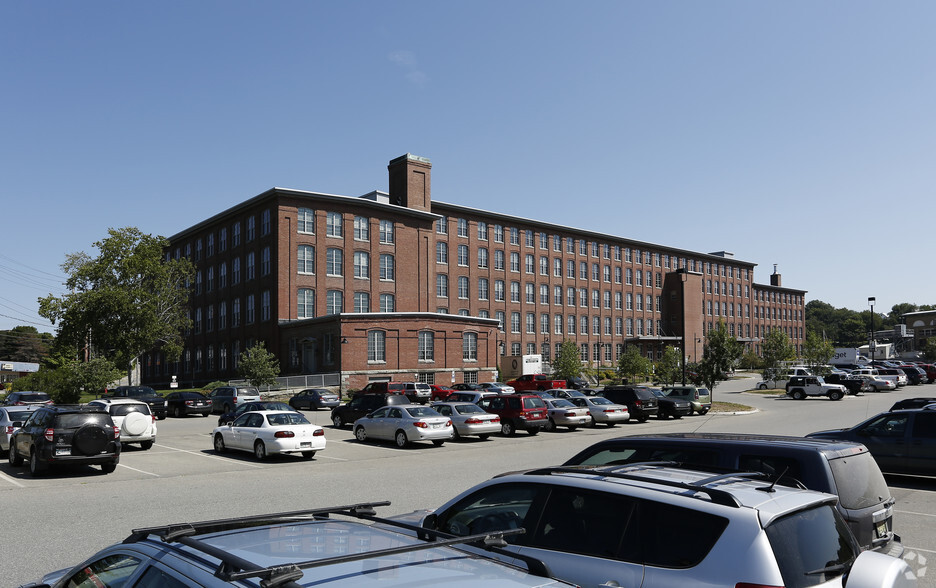
The old Lockwood-Dutchess Textile Mill, on Water St., in Waterville. Now the Hathaway Creative Center. It was a mill where many Canadians went to work upon their relocation to Waterville.
The Civil War and post-war industrial development encouraged more immigration. For Waterville, Chenard wrote, the opening of the Lockwood Cotton Mill at the north end of Water Street in 1874 “attracted the greatest number of Franco-American immigrants.”
Mill owners sent representatives to the Province of Québec to solicit workers. Chenard wrote that substantial immigration continued until 1896, when the province got its first French-Canadian minister and all of Canada became more prosperous.
Kingsbury wrote that in the first six months of 1892, the Lockwood Mill produced “8,752,682 yards of cotton cloth, weighing 2,978,000 pounds. To produce these large results, 2,100 looms, 90,000 spindles and the labor of 1,250 people ten hours each week day are required.” In addition, the mill employed 50 to 75 “skilled mechanics” to keep the machinery running.
Chenard wrote that a small minority of the immigrants were doctors or other professional people, but most were extremely poor, and working in the mill was not a way to get rich. “Even the best weavers made only $1 a day”; average workers made 25 to 50 cents a day.
The mill owners helped workers find conveniently-located housing, Chenard wrote. There were “large boarding houses or small cozy homes known as ‘maison de la compagnie [company house],’ which were mostly owned by the Lockwood Company.” Another choice was an apartment in what Chenard called the Bang’s estate, “a long row of tiny red-painted houses.”
Kingsbury wrote that the French Catholic church in Waterville started as a mission served from Bangor, beginning in the 1840s. Chenard described as “Waterville’s first Catholic Church,” St. John’s on Grove Street, built by Jesuit missionary Father Jean Bapst. Pepper quoted an 1851 article from the Waterville Mail encouraging “those connected with other sects” to support the effort to provide a Catholic house of worship.
The first resident pastor was Father Nicolyn, in 1857. After two other priests, Father D. J. Halde came in 1870 and in 1871 bought a lot on Elm Street and had a larger church, St. Francis de Sales Catholic Church, built. It opened in 1874; Kingsbury said it cost $22,000, plus another $8,000 in following years (to 1892).
By 1874, Chenard said, St. John’s church had been moved to Temple Court and converted to a school. By 1902, Pepper wrote, it was a private home.
In 1880, Kingsbury wrote, Father Halde was succeeded by Father Narcisse Charland, who in 1886 bought a house for a “parochial residence” for $3,600 plus $1,000 worth of repair work. The next year the priest spent another $7,000 to build a parochial school, opened in 1888, which contributed to providing education for mill workers’ children.
In 1891 Father Charland invested $8,788 to build and furnish the Orders of Sisters Ursulines convent. Kingsbury wrote that it served “as a residence for the sisters, a boarding house for girls, and has class rooms for recitations.”
In 1892, Kingsbury wrote, there were between 450 and 480 parochial school students, 21 of them boarders. The church seated 1,100 and had two Sunday morning services, but was “too small to accommodate the worshippers from this large and growing parish, which numbers, including Winslow, over 3,000 souls.”
At that time, Kingsbury continued, Father Charland was also holding monthly services at missions in Vassalboro (see below) and Oakland.
Meanwhile, Chenard wrote that Waterville’s Second Baptist Church, also called the French Baptist Church, opened on Water Street in 1884.
Chenard went on to list a variety of French-Canadian organizations that provided social services to the French community, and cultural activities – music, drama – that spread to the entire Waterville community. Plocher added, “The Franco-Americans also introduced hockey to the city.”
Plocher and Chenard agreed that relations between French-Canadians and the rest of Waterville improved over the years. Plocher wrote, “The Anglos in Waterville were forced to adjust to the new presence, and although there was some prejudice in the Yankee population, it was not long before every business had at least one French-speaking employee.”
Whittemore and Chenard both reported much animosity between the young men of the two communities in early days. Whittemore wrote that young Anglos did not visit The Plains “with good intent,” and when young Francos came into Anglo territory “they came in bands strong enough for offense or defense, as the case might require,” sometimes adding out-of-town muscle.
The two writers further agreed that the animosity was past. “In time, it gave way to a more peaceful understanding which often resulted in warm friendships,” Chenard wrote.
Pepper’s view was that relations among adults were reasonably friendly all along. He wrote that Protestants contributed to St. John’s Chapel in the 1850s and to “larger and later” Catholic enterprises. The Mail often ran notes from the Catholic priest of the time thanking all Waterville people for “generous aid furnished especially in connection with church fairs,” he wrote.
“This liberal disposition and grateful appreciation at and from the beginning have contributed not a little to the development of that marked good will which has ever characterized the mutual relations of Catholics and Protestants, French and Americans in this town and its neighborhood,” Pepper said.
As evidence of late 19th-century integration, Chenard called Frederick Pooler/Poulin “the ‘Father’ of French politicians in Waterville,” elected selectman in 1883 and 1887, member of the first board of aldermen after Waterville became a city on Jan. 12, 1888, overseer of the poor from 1889 to 1892, board of education member in 1898-99 and legislative representative in 1906.
* * * * * *
In Fairfield, according to the Fairfield Historical Society, the first French Catholic Mass was celebrated in 1870 by Father Halde, from Waterville, “in a public hall.” By 1882 there were 104 French-Canadian families in the town, and Bishop Healy had Father Charland from Waterville put up “a small chapel on the grounds of the present church” on High Street.
The first “resident pastor” was Rev. Louis Bergoin, in 1891. The history says he thought “the chapel was too small”; it gives no date for the building of the larger church, but says Right Rev. William H. O’Connell, Bishop of Portland, visited the Church of the Immaculate Heart of Mary for the first time on Aug. 18, 1901.
A Portland Press Herald article from April 27, 2015, says the building was put up in 1895. The article says “The church was closed by the Waterville-based Corpus Christi Parish four years ago at the same time it shuttered St. Theresa Church, in Oakland, and St. Bridget Church, in Vassalboro.” New owners in April 2015 planned to convert it to their home.
* * * * * *
Speaking of St. Bridget’s Church, in Vassalboro, it, too, was built primarily by and for an immigrant population of mostly mill workers, the Irish who came to North Vassalboro beginning in the 1840s to work in John D. Lang’s woolen mill. In her history of Vassalboro, Alma Pierce Robbins told the story of the church as she found it in “an anonymously-written history” from 1926.
Robbins explained that Vassalboro businessmen had already opened sawmills, gristmills and tanneries in North Vassalboro, using waterpower supplied by China Lake’s Outlet Stream. But the woolen mill required workers with different skills, so, she wrote, Lang and partners advertised “in English and Irish newspapers.”
The ads brought many Irish workers, both from Ireland and from earlier Irish communities in Boston and as far away as New York. Robbins found in the 1850 federal census a list of “new names” in Vassalboro with the countries of origin. Thirty-eight families were from Ireland; 12 were from England; four were from Canada; two were from Scotland; and John McCormack’s birthplace was given as “Atlantic Ocean.”
Many of the Irish were Catholic, and the nearest Catholic church, in Waterville, was a five-mile walk, Robbins wrote. Irish workers began departing for other mill towns where Catholic churches were nearby.
The unnamed mill agent in 1857 arranged for Mass to be said in workers’ homes. When attendees overflowed the houses, the “old Engine House Hall” became the new venue, where Waterville priests held services, at first four times a year and later once a month.
Workers continued to move away, however, and, Robbins wrote, in or a bit before 1874 mill agent George Wilkins, with the help of Waterville’s Father Halde, bought from the mill owners a lot at the intersection of Main Street and Oak Grove Road on which to found St. Bridget’s Catholic Church.
The original building was moved farther south on Main Street and served until it was destroyed by fire on Nov. 5, 1925. A new building was started the next year; the first service was Nov. 14, 1926.
St. Bridget’s Church was also sold and is now Vassalboro’s St. Bridget Center, available for rent for private and public gatherings.
Main sources
Fairfield Historical Society, Fairfield, Maine 1788-1988 (1988).
Kingsbury, Henry D., ed., Illustrated History of Kennebec County Maine 1625-1892 (1892).
Plocher, Stephen, Colby College Class of 2007, A Short History of Waterville, Maine
Found on the web at Waterville-maine.gov.
Robbins, Alma Pierce, History of Vassalborough Maine 1771 1971 n.d. (1971).
Whittemore, Rev. Edwin Carey, Centennial History of Waterville 1802-1902 (1902)
Websites, miscellaneous.
Interesting links
Here are some interesting links for you! Enjoy your stay :)Site Map
- Issue for July 3, 2025
- Issue for June 26, 2025
- Issue for June 19, 2025
- Issue for June 12, 2025
- Issue for June 5, 2025
- Issue for May 29, 2025
- Issue for May 22, 2025
- Issue for May 15, 2025
- Issue for May 8, 2025
- Issue for May 1, 2025
- Issue for April 24, 2025
- Issue for April 17, 2025
- Issue for April 10, 2025
- Issue for April 3, 2025
- Issue for March 27, 2025
- Issue for March 20, 2025
- Issue for March 13, 2025
- Issue for March 6, 2025
- Issue for February 27, 2025
- Issue for February 20, 2025
- Issue for February 13, 2025
- Issue for February 6, 2025
- Issue for January 30, 2025
- Issue for January 23, 2025
- Issue for January 16, 2025
- Issue for January 9, 2025
- Issue for January 2, 2025
- Sections
- Our Town’s Services
- Classifieds
- About Us
- Original Columnists
- Community Commentary
- The Best View
- Eric’s Tech Talk
- The Frugal Mainer
- Garden Works
- Give Us Your Best Shot!
- Growing Your Business
- INside the OUTside
- I’m Just Curious
- Maine Memories
- Mary Grow’s community reporting
- Messing About in the Maine Woods
- The Money Minute
- Pages in Time
- Review Potpourri
- Scores & Outdoors
- Small Space Gardening
- Student Writers’ Program
- Solon & Beyond
- Tim’s Tunes
- Veterans Corner
- Donate




